Overview
The FHIR interoperability standard is revolutionizing healthcare integration. By streamlining data exchange, we are not just improving patient care; we are facilitating real-time access to medical information across diverse systems. This transformation enables seamless communication, reduces errors, and fosters collaboration among healthcare providers. Ultimately, we are driving better patient outcomes and enhancing operational efficiencies.
What’s holding your team back from embracing this change? We invite you to explore how FHIR can empower your organization to achieve these critical advancements in healthcare.
Introduction
In the rapidly evolving landscape of healthcare, we recognize that the integration of technology plays a pivotal role in enhancing patient care and operational efficiency. Central to this transformation is the Fast Healthcare Interoperability Resources (FHIR) standard, which streamlines data exchange across disparate systems.
Our innovative hybrid integration platform emerges as a vital tool, enabling healthcare organizations to seamlessly adopt FHIR standards and foster real-time access to critical patient information.
As healthcare providers strive to improve collaboration and reduce errors, the ability to share data effortlessly becomes essential.
What’s holding your team back from achieving this level of efficiency?
This article delves into the multifaceted benefits of FHIR integration, exploring its impact on interoperability, patient engagement, cost efficiency, and regulatory compliance, while highlighting how we empower organizations to navigate the complexities of modern healthcare integration effectively.
Avato: Streamline FHIR Integration for Enhanced Data Exchange
We understand that in today’s healthcare landscape, seamless integration is not just a luxury—it’s a necessity. Avato’s hybrid integration platform is meticulously crafted to simplify the integration process, empowering medical organizations to connect diverse systems and significantly enhance information exchange. By leveraging our platform, organizations can swiftly adopt the FHIR interoperability standard, ensuring a smooth flow of information across various medical applications. This capability is vital for improving healthcare delivery and operational efficiency, as it facilitates real-time access to essential health information across multiple platforms, alongside ongoing monitoring and alerts regarding system performance.
The implementation of the FHIR interoperability standard is recognized as essential for achieving seamless information transfer within the medical field. Successful examples of health data exchange implementation illustrate how medical providers can enhance care coordination and improve patient outcomes.
Our commitment to facilitating health information exchange integration not only streamlines complex projects but also aligns with the growing demand for effective information sharing. The hybrid integration platform maximizes and extends the value of legacy systems, allowing organizations to manage intricate integrations effortlessly while significantly reducing costs. As Gustavo Estrada aptly noted, “Avato delivers results within desired time frames and budget constraints.” With Avato, medical organizations can adeptly navigate the complexities of integration while ensuring compliance with industry regulations and security protocols, ultimately maintaining a competitive edge in the sector.
What’s holding your team back from achieving this level of integration? Let us partner with you to unlock the potential of your systems and enhance your operational capabilities.
Improved Interoperability: Facilitating Seamless Patient Data Sharing
The application of the FHIR interoperability standard is paramount in enhancing interoperability, allowing us to exchange information seamlessly. This advancement significantly mitigates the risk of errors and strengthens care coordination. With FHIR, we facilitate real-time information exchange, allowing clinicians to access detailed medical histories precisely when needed. Such capabilities not only elevate the quality of care but also foster collaboration among healthcare teams, ultimately leading to better patient outcomes.
A recent study highlighted that 331 alerts were necessary to prevent a single adverse drug event (ADE), underscoring the critical need for effective information sharing in clinical settings. Our standard directly addresses this challenge by enabling real-time information sharing, ensuring that clinicians have access to the most current details, thereby reducing the likelihood of mistakes that could lead to ADEs.
Furthermore, specialists emphasize that the FHIR interoperability standard is the cornerstone of modern medical practices, enhancing decision-making and bolstering patient safety. The real-time information exchange facilitated by our FHIR interoperability standard has proven transformative, as demonstrated by case studies showcasing improved interoperability and communication among medical information analysts. These interpersonal skills are vital for successful medical projects, allowing analysts to collaborate efficiently and implement interoperability standards.
At Avato, our dedicated hybrid integration platform plays a crucial role in streamlining these processes and enhancing business value through effective information management. As the medical landscape evolves, the impact of the FHIR interoperability standard on patient information sharing remains substantial, driving efficiencies and nurturing a culture of analytics that enhances overall patient care.
For banking IT supervisors, considering the implications of interoperability could lead to enhanced information management practices and improved integration of medical systems.
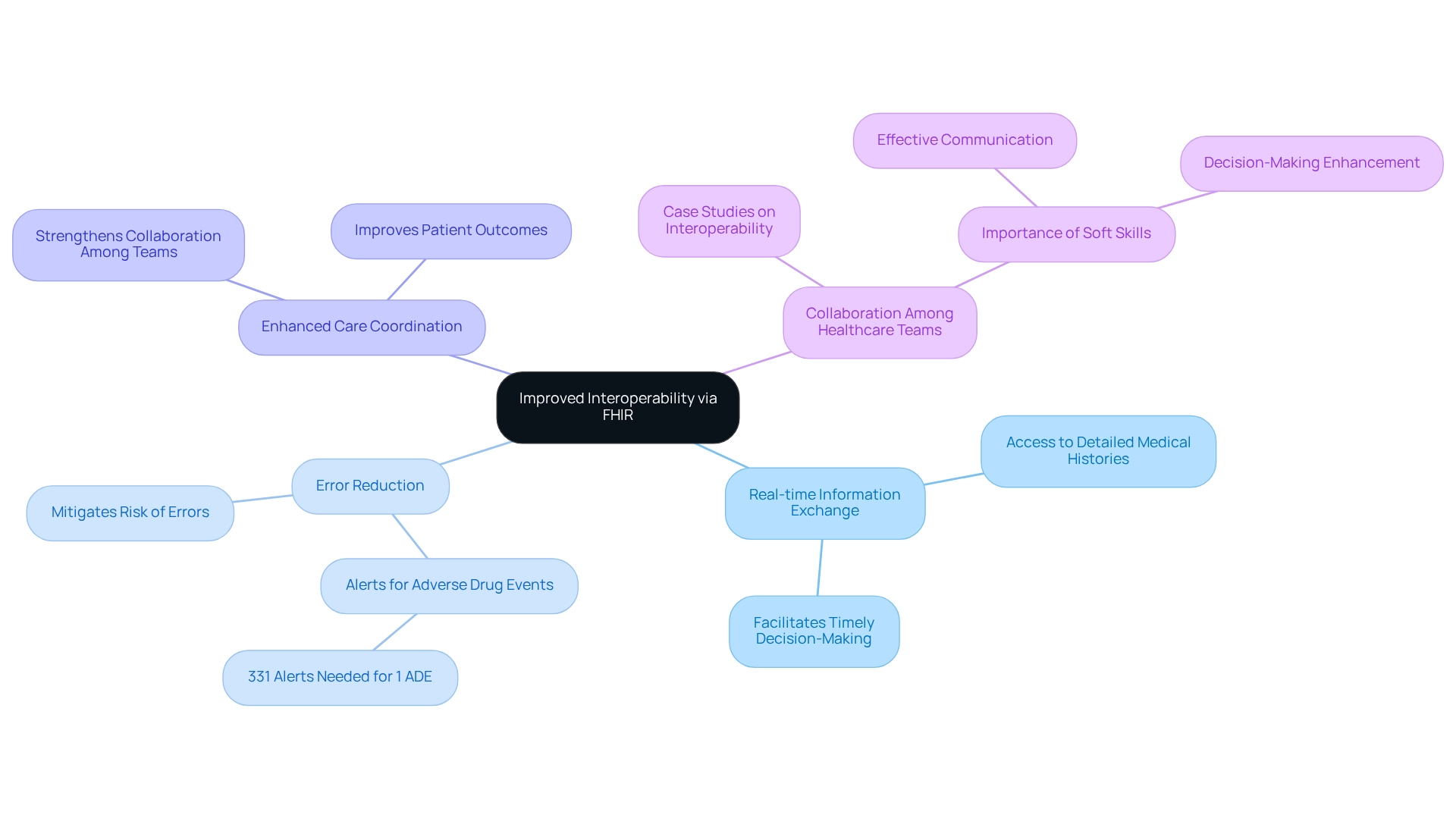
Resource-Based Architecture: Adapting to Evolving Healthcare Needs
We recognize that the resource-based architecture empowers medical organizations to swiftly adapt to evolving needs by providing a flexible framework for data exchange. Each resource within this framework encapsulates a distinct element of healthcare information, such as individual demographics or medication records. This modular design enables us to implement updates without necessitating a complete system overhaul, facilitating the integration of new technologies and compliance with regulatory standards.
As the adoption of health data standards accelerates, we project that by 2025, this architecture will streamline operations and enhance patient care across health systems. The significance of this architecture becomes increasingly evident, especially for organizations facing challenges in global health information exchange adoption, such as technical complexity, privacy concerns, and resource limitations. By leveraging our hybrid integration platform, which utilizes XSLT—a highly-tuned declarative programming language—for efficient XML data transformation, we can effectively address these issues while reducing programming errors and costs associated with data management.
Furthermore, the adaptability of the FHIR interoperability standard allows medical providers to respond promptly to shifting demands, ensuring they remain compliant and competitive in a rapidly changing environment. This adaptability is crucial as medical systems strive to enhance the FHIR interoperability standard and improve the quality of service provided to individuals. Our commitment to simplifying disparate systems through dedicated integration solutions reflects our deep dedication to architecting technology foundations that empower organizations to navigate these complexities. As noted by the IMARC Team, “The report is excellent and contains a substantial amount of information, and our team is extremely pleased with the details provided,” which underscores the importance of thorough information in comprehending FHIR’s impact.
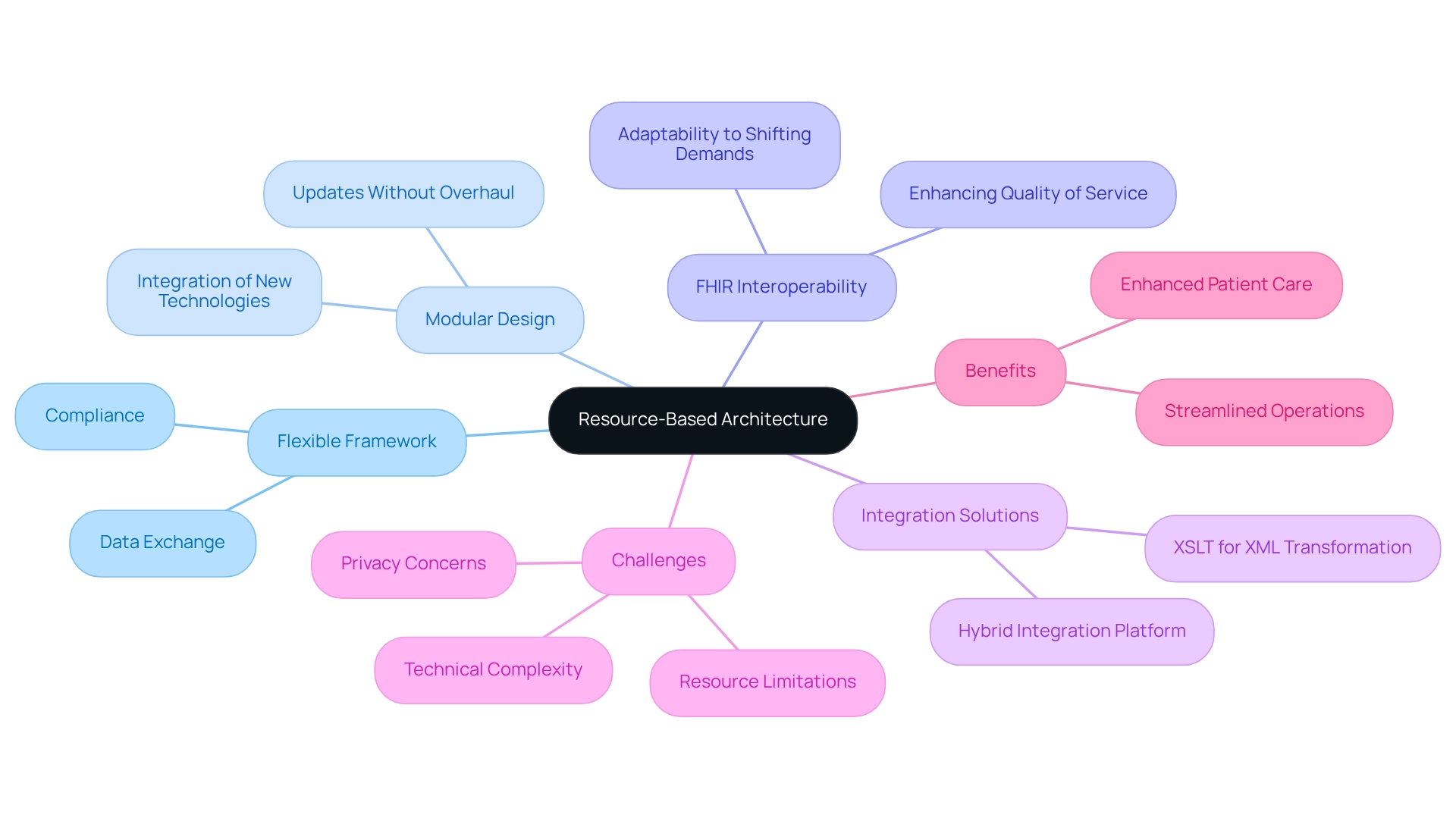
Real-Time Access: Leveraging RESTful APIs for Timely Decision-Making
At the forefront of healthcare innovation, we recognize that utilizing RESTful APIs is essential for enabling care providers to access individual data in real time. This capability is not just an advantage; it is crucial in emergency scenarios, where immediate access to medical histories can dramatically influence patient outcomes. For instance, medical organizations that have integrated RESTful APIs report significant improvements in their responsiveness, leading to enhanced patient care. A recent study emphasized that broad implementation of health information APIs is vital in addressing management challenges, with numerous organizations observing a marked increase in decision-making efficiency.
Furthermore, our committed hybrid integration platform guarantees 24/7 availability for essential integrations, underscoring the dependability of systems that leverage RESTful APIs. This reliability is vital for prompt decision-making in healthcare. Experts have noted that immediate access to patient information via the fhir interoperability standard not only streamlines workflows but also fosters improved clinical results. Kenneth D Mandl observed that this research was supported by the Office of the National Coordinator of Health Information Technology, highlighting the importance of continuous collaboration in enhancing the fhir interoperability standard and advancing API capabilities.
As the medical landscape evolves, we understand that the integration of RESTful APIs will continue to play a pivotal role in ensuring providers can act swiftly and effectively, ultimately improving the quality of care delivered. Moreover, the effectiveness of SMART/HL7 Bulk interoperability in facilitating large-scale information exchange reinforces the need for optimization within current EHR platforms, thereby emphasizing the significance of our hybrid integration solutions in line with the FHIR interoperability standard in modern medical systems. What’s holding your team back from achieving this level of integration? Let us partner with you to enhance your capabilities and improve patient outcomes.
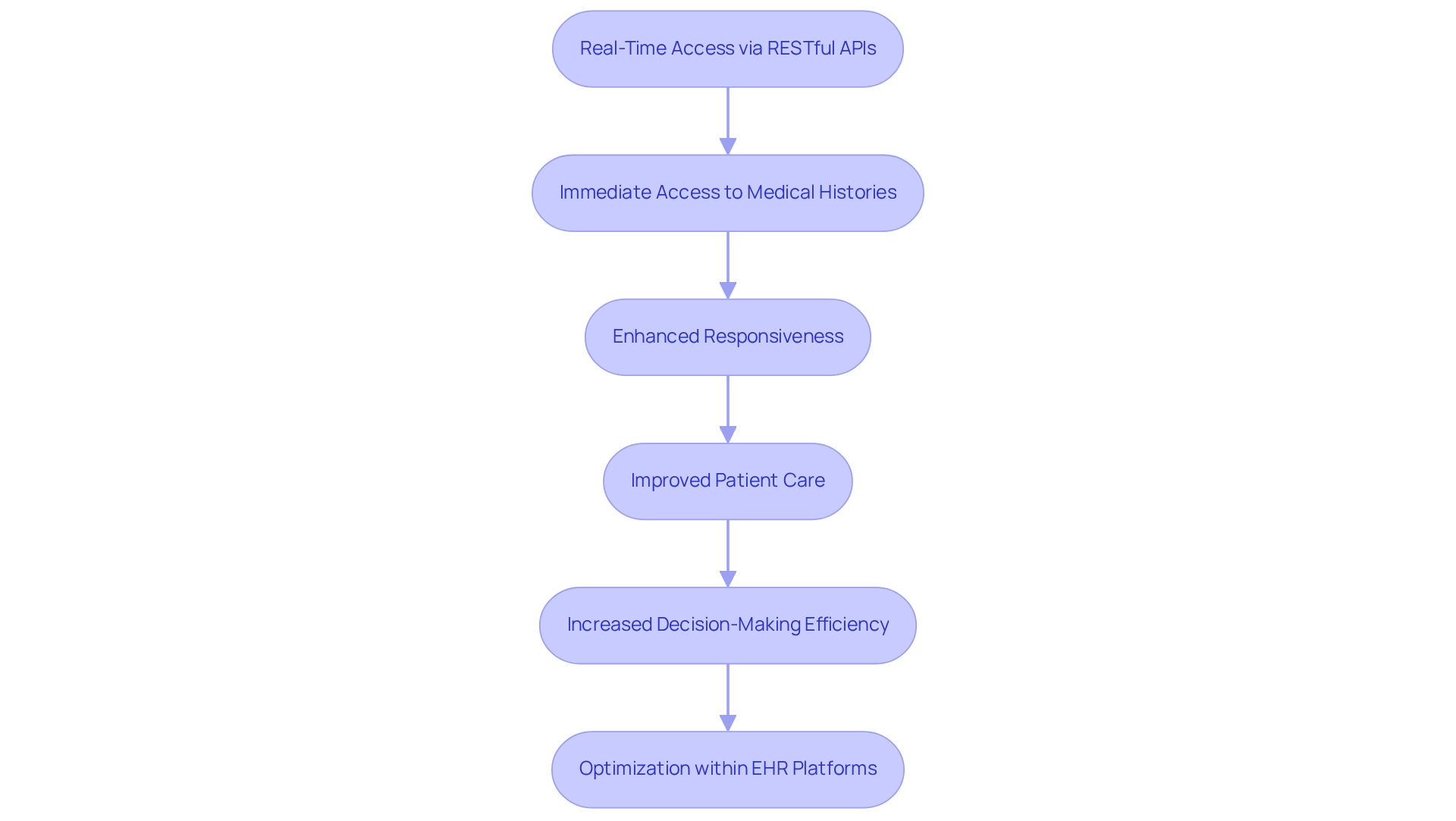
Global Adoption: Standardizing Data Sharing Across Borders
We recognize the pressing need for enhanced integration of diverse systems and information in healthcare using the FHIR interoperability standard. This realization led us to establish a specialized hybrid integration platform that is now transforming the global exchange of medical information. By creating standardized formats and protocols based on the FHIR interoperability standard, we are paving the way for international individual summaries and cross-border health information exchanges.
This standardization is crucial for fostering cooperation among medical organizations, irrespective of their geographical locations, by adhering to the FHIR interoperability standard. As we approach 2025, we anticipate a significant rise in cross-border health information exchanges, with adoption rates surging as medical systems begin to realize the potential for improved information sharing and patient outcomes. Notably, legislation now prohibits data blocking by health information technology vendors, further streamlining this process.
We emphasize the importance of focusing on significant medical innovations rooted in evidence and organizational goals to optimize the advantages of FHIR. John Brownstein aptly highlights this focus as essential in promoting effective medical solutions. Our case studies demonstrate how organizations leveraging the FHIR interoperability standard have successfully navigated complex integration challenges, resulting in enhanced operational capabilities and reduced costs.
Our dedicated hybrid integration platform exemplifies this approach, specifically addressing the challenges of health information integration and empowering medical systems to modernize their operations efficiently. By unlocking isolated assets and fostering seamless information connectivity, we enhance business value creation, making our platform particularly relevant for banking IT managers concerned with information security and operational efficiency in integrations.
The global impact of the FHIR interoperability standard on medical information sharing is profound; it not only standardizes individual data exchange worldwide but also cultivates a more interconnected medical ecosystem. What’s holding your team back from embracing this transformative change?
Enhanced Patient Engagement: Supporting Mobile and Cloud Applications
We enable the development of mobile and cloud applications that significantly enhance user engagement by streamlining access to health information. Through these applications, individuals can effortlessly view their medical records, schedule appointments, and communicate directly with medical professionals. This empowerment not only gives individuals control over their health information but also fosters a collaborative healthcare environment, encouraging them to take an active role in managing their health.
The integration of AI and VR technologies into these applications further humanizes care, allowing for innovative treatments that can reduce pain perception and enhance overall experiences. For instance, the use of VR in pain management has demonstrated remarkable results, as individuals can engage in immersive environments that divert their attention from discomfort during procedures.
With 68% of consumers favoring electronic payment options for medical bills, the incorporation of health data standards into mobile health applications is becoming more essential. Furthermore, as one expert noted, “62% of smartphone owners utilize their devices to seek information about health conditions,” highlighting the demand for accessible, user-friendly applications.
Healthcare providers and organizations that have not yet adopted mobile health devices should consider these current trends and statistics to remain competitive. Moreover, the impact of social platforms on medical decisions cannot be ignored; a strong online presence enables providers to inform and connect with individuals, cultivating trust and community.
By utilizing the fhir interoperability standard, we can meet these expectations, ultimately improving client involvement and satisfaction. To optimize the advantages of health information exchange integration, we should emphasize the creation of mobile applications that not only offer information but also enable significant interactions between individuals and providers, incorporating the latest advancements in digital medicine, such as AI avatars that can help individuals in understanding their treatment options.
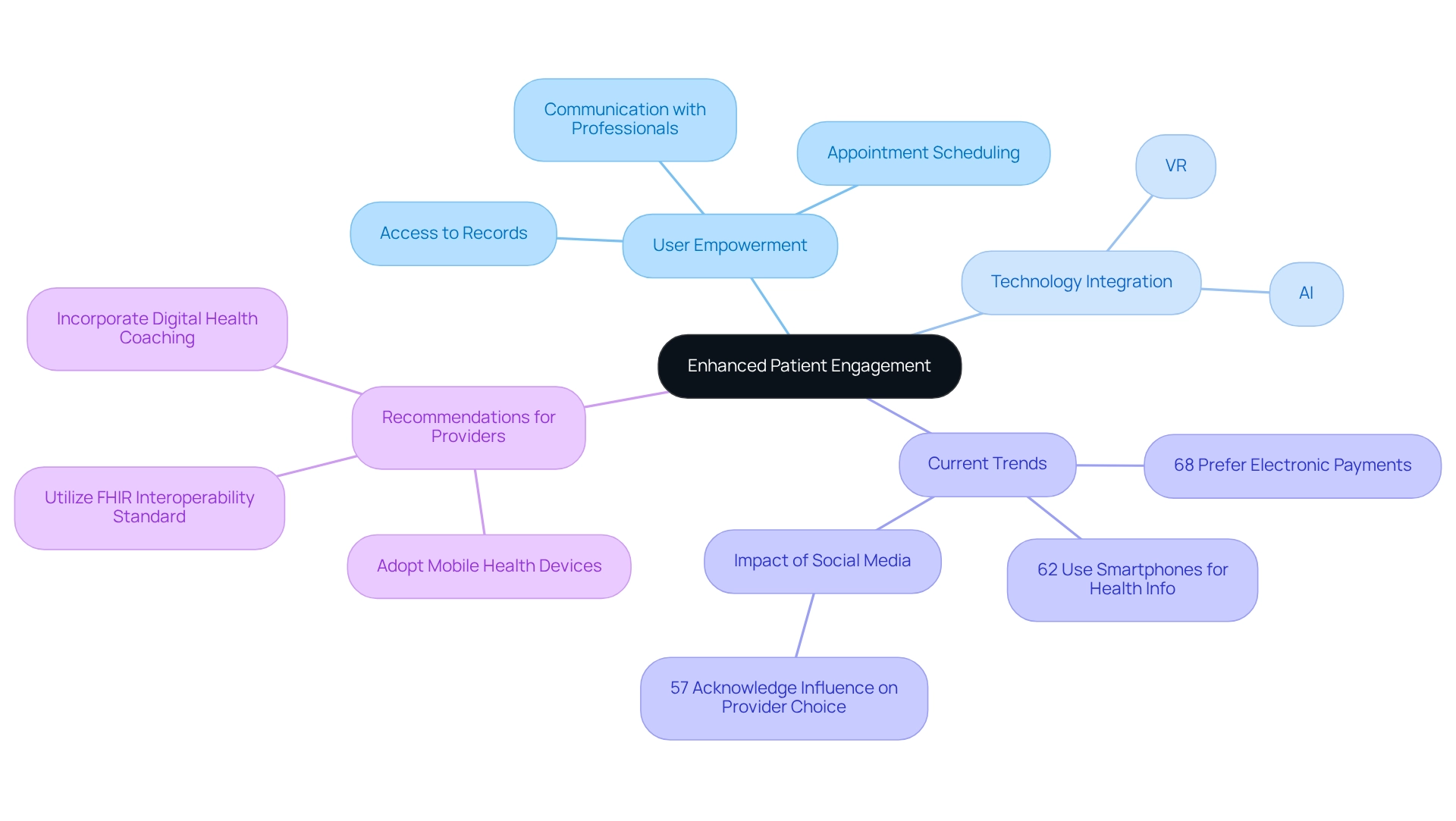
AI Integration: Utilizing FHIR for Enhanced Decision-Making
Integrating AI with FHIR empowers us to significantly enhance decision-making processes within medical organizations by leveraging structured information for predictive analytics and clinical decision support. Our AI algorithms efficiently analyze extensive volumes of FHIR-compliant data, enabling the identification of trends, prediction of outcomes, and formulation of personalized treatment plans. This integration not only enhances the precision of clinical decisions but also simplifies medical delivery, ultimately resulting in better care for individuals.
The progress in digital medicine, especially through the application of AI and VR, is crucial in personalizing care for people. For instance, virtual reality applications have demonstrated significant success in addressing conditions such as PTSD, where immersive experiences assist individuals in confronting and processing traumatic events. Such innovative methods emphasize our capability to improve patient involvement and treatment effectiveness, aligning seamlessly with the objectives of integration. Recent studies suggest that advancements in analytics could transform medical delivery, personalized medicine, and biomedical research.
Graphical representations of healthcare data sets have been created to demonstrate the usefulness of data analytics prototypes, highlighting their potential in practical applications. Furthermore, with 73% of physicians in surgical fields voicing concerns about AI’s effect on job levels, the incorporation of AI with the FHIR interoperability standard offers a chance to alleviate these anxieties by improving operational effectiveness rather than substituting human skills.
As we continue to explore the potential of AI alongside the FHIR interoperability standard, the outlook for predictive analytics in the medical sector appears bright. Case studies emphasize successful applications where our AI integration with health information standards has resulted in enhanced clinical decision-making, showcasing the benefits of this method in managing the complexities of contemporary medical settings.
Gustavo Estrada observed, ‘Avato has the capability to simplify intricate projects and provide outcomes within preferred timelines and budget limitations,’ illustrating the potential of our AI integration to enhance medical processes. Additionally, the case study titled ‘Future Directions for Clinical Information Analytics‘ underscores the necessity for better tools and methods to utilize the increasing amount of clinical information, proposing that advancements in analytics could lead to notable enhancements in medical delivery and personalized treatment.
Staying informed about the latest industry news and research analysis of AI in the medical field, as offered by our blog, will further enhance understanding of these developments.
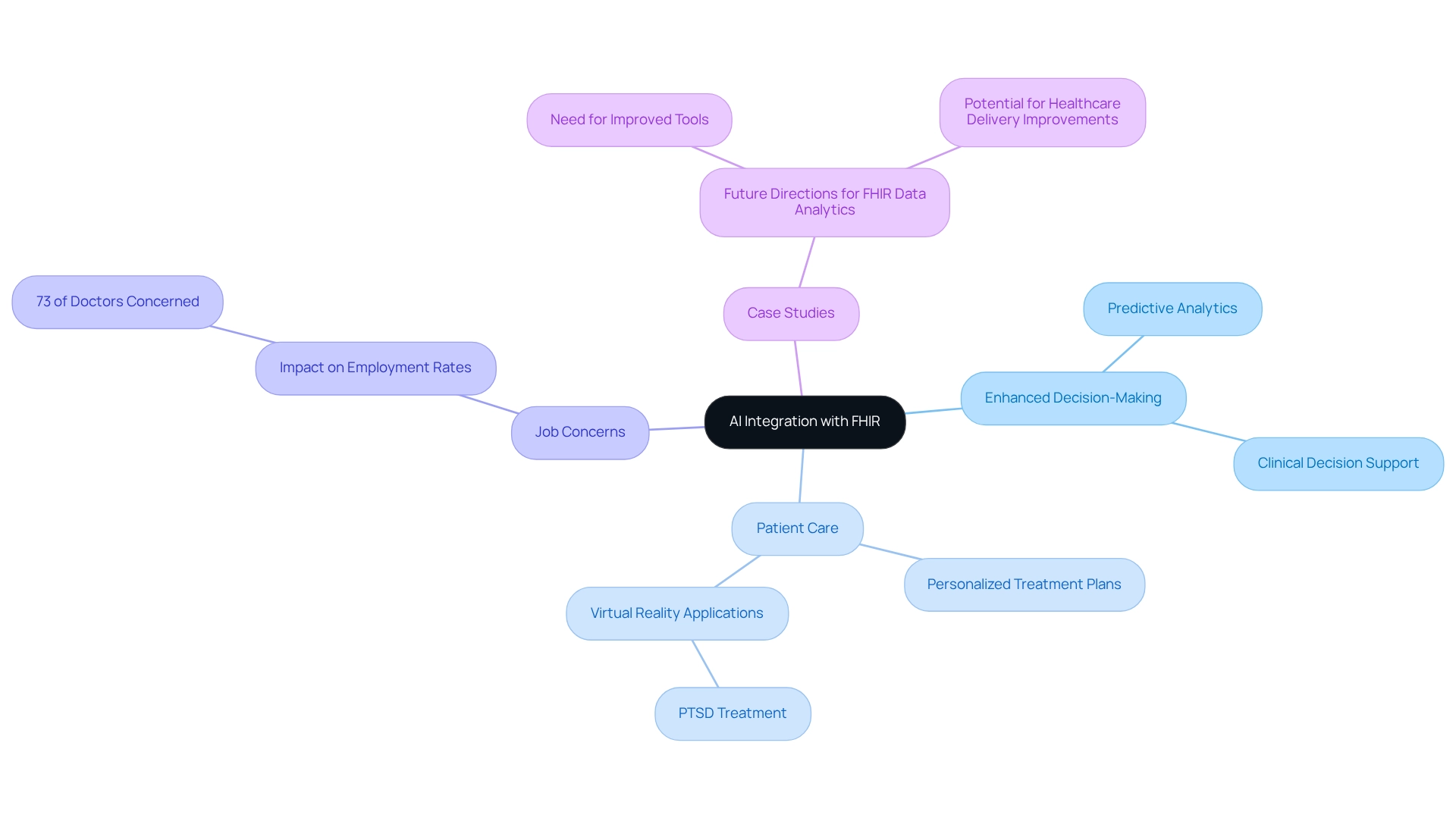
Cost Efficiency: Reducing Operational Expenses Through Streamlined Data Management
Adopting standardized protocols can lead to significant decreases in operational costs for medical organizations by optimizing information management processes. We recognize that Avato’s dedicated hybrid integration platform plays a crucial role in this by simplifying the integration of disparate systems and eliminating the necessity for expensive custom integrations. With features such as pre-built connectors and support for various information formats, our platform enhances the integration process, enabling organizations to utilize standardized information formats and protocols inherent in FHIR. This not only reduces administrative burdens but also allows organizations to redistribute resources more efficiently, concentrating on patient care rather than the challenges of managing separate data systems, as the FHIR interoperability standard gains understanding and acceptance, particularly in the Asia-Pacific region.
We anticipate that healthcare organizations could realize up to 10% in cost reductions. This projection is based on the growing acknowledgment of the advantages that the FHIR interoperability standard brings while lowering expenses. Experts have noted that although obstacles to adopting health information exchange standards exist, the potential for cost savings frequently outweighs the time invested in developing solutions based on those standards. A notable case study highlights the establishment of a marketplace for applications, which could enhance interoperability among different EHR systems. This initiative not only fosters innovation but also provides organizations with more compatible tools, directly contributing to reduced operational costs by streamlining integration processes through our platform.
Furthermore, incentives for EHR vendors and clinical organizations to endorse standardized frameworks and common ontologies could further diminish barriers to interoperable CCDS development and integration, reinforcing our commitment to cost efficiency.
In summary, the ability to simplify information exchange among diverse medical systems, supported by Avato’s hybrid integration platform, positions us as a vital partner in lowering operational expenses. By leveraging healthcare data standards, we empower medical providers to control expenses effectively while enhancing patient care outcomes. Additionally, when evaluating formats, the choice between JSON and XML can influence integration efficiency. JSON often presents a more lightweight option suitable for modern web services, whereas XML offers robust schema validation capabilities. Understanding these differences enables us to further empower organizations to optimize their integration strategies.
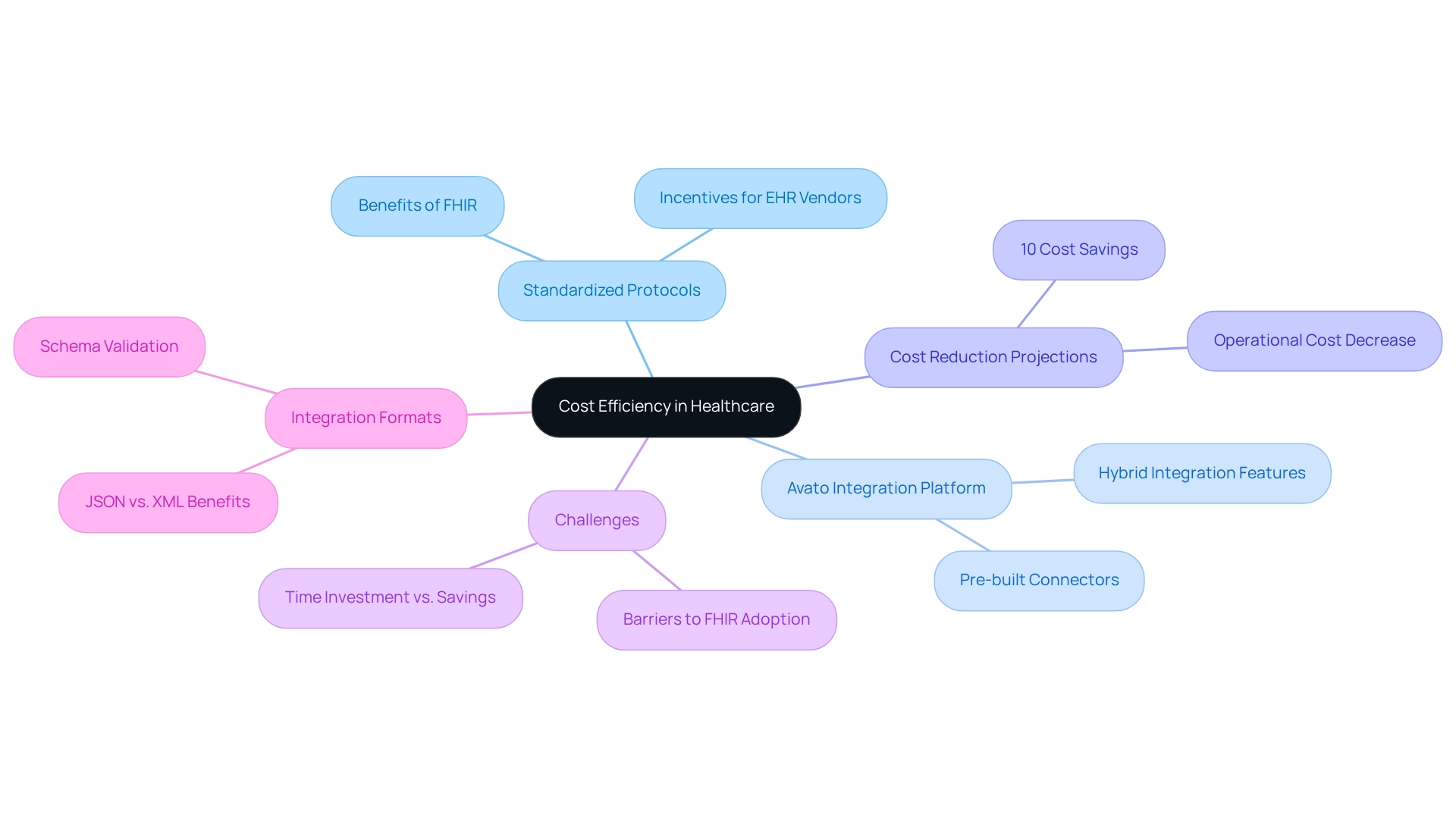
Overcoming Barriers: FHIR’s Role in Enhancing Interoperability
The FHIR interoperability standard is essential for addressing the interoperability challenges faced by medical organizations, particularly those stemming from fragmented systems and diverse information formats. Many medical organizations grapple with these issues, which obstruct effective communication and information sharing. By adopting the FHIR interoperability standard, we can streamline our information exchange processes, fostering improved collaboration and ultimately enhancing patient care across various systems.
At Avato, we are committed to simplifying these complex integration challenges. Our name, derived from the Hungarian word for ‘of dedication,’ reflects our dedication to architecting the technology foundation necessary for delivering rich, connected customer experiences. With our dedicated hybrid integration platform, we empower medical organizations to enhance their business value through seamless and secure information connectivity. Notably, statistics indicate that 56% of regional Health Information Exchanges (HIEs) intend to participate in the Trusted Exchange Framework and Common Agreement (TEFCA), highlighting a growing commitment to overcoming interoperability challenges. This underscores the industry’s recognition that standardized information exchange is crucial for effective communication and collaboration among medical providers. However, despite the potential of the FHIR interoperability standard, its current deployment remains limited, suggesting that while it represents progress, it is not yet a comprehensive solution to existing interoperability challenges.
Expert opinions underscore the necessity of standardization in healthcare information exchange. A hospital representative noted the multitude of platforms where information can reside, stating, “It’s one of those things where now you’ve got to subscribe to it [a regional HIE], and it’s another place [an application] for you to go to seek additional details [patient clinical information]. There are too many locations for information to land and be sent. People just stop looking.” This sentiment reflects broader industry challenges, emphasizing the urgent need for a unified approach to information sharing that can alleviate confusion and enhance efficiency.
Case studies illustrate how medical organizations are beginning to adopt interoperability frameworks to bolster their information sharing capabilities. For instance, entities that have embraced these standards report improvements in information accessibility and collaboration among medical professionals, leading to more effective patient care. As the medical landscape evolves, the significance of standardized information exchange through the FHIR interoperability standard becomes increasingly apparent, establishing it as a crucial element in addressing interoperability obstacles and fostering a more cohesive system. Furthermore, addressing the challenges and opportunities for interoperability across technological, organizational, and environmental domains is vital for unlocking the full potential of the standard in enhancing integration within the medical field. To explore how Avato can assist your organization in navigating these challenges, we encourage you to reach out to our team of integration experts.
Regulatory Compliance: Ensuring Adherence to Healthcare Standards
We recognize that standards play a crucial role in assisting healthcare organizations to achieve regulatory compliance. By providing a uniform framework for information exchange that aligns with the FHIR interoperability standard and industry regulations, we help our partners confirm their commitment to data security and individual privacy—key components of regulatory compliance. This commitment not only reduces the likelihood of facing penalties but also enhances trust among patients and stakeholders alike.
The implementation of these standards has been demonstrated to streamline medical record requests, considerably decreasing the chances of mistakes and inconsistencies. This simplification directly impacts compliance efforts by ensuring that data is exchanged accurately and efficiently, which is crucial for meeting regulatory requirements. For instance, medical service providers that have adopted these standards report enhanced operational efficiency and a streamlined approach to compliance. Furthermore, engaging with advisory services for long-term compliance has proven advantageous; organizations that collaborate with external compliance specialists can stay ahead of regulatory changes and adopt best practices customized to healthcare standards. Educating medical providers, administrators, and IT experts in health data exchange implementation is essential for maximizing these advantages.
As we approach 2025, the focus on data security within the healthcare framework is more pronounced than ever. Healthcare organizations are actively demonstrating their compliance through robust data protection measures. The extensive backing for these standards, especially the R4 edition, has established the FHIR interoperability standard as the favored option for numerous healthcare systems. As noted, ‘The simplicity and flexibility of R4, alongside its widespread support, make it the go-to for most health systems,’ further solidifying its role in ensuring compliance with the FHIR interoperability standard. This strategic alignment not only protects individual information but also positions organizations advantageously in a more regulated environment.
Key Benefits of FHIR for Regulatory Compliance:
- We simplify medical record requests, reducing errors and discrepancies.
- We enhance operational efficiency in compliance processes.
- We provide a standardized framework that aligns with the FHIR interoperability standard and industry regulations.
- We facilitate collaboration with external compliance experts for tailored strategies.
- We ensure robust data protection measures to safeguard patient information.

Conclusion
The integration of FHIR standards is revolutionizing the healthcare landscape, significantly enhancing data interoperability and patient care outcomes. Through our hybrid integration platform, we empower healthcare organizations to streamline the adoption of FHIR, facilitating real-time access to critical patient information and fostering collaboration among care teams. This seamless data exchange minimizes the risk of errors and empowers healthcare providers to make informed decisions swiftly, ultimately improving patient safety and quality of care.
Moreover, the resource-based architecture of FHIR enables organizations to adapt efficiently to evolving healthcare demands, ensuring compliance with industry regulations without necessitating complete system overhauls. As healthcare providers increasingly embrace mobile and cloud applications powered by FHIR, we anticipate a rise in patient engagement and satisfaction, allowing patients to take a more active role in managing their health.
The global adoption of FHIR is pivotal for standardizing data sharing across borders, enhancing collaboration among healthcare providers regardless of geographical location. As organizations navigate the complexities of interoperability, the benefits of adopting FHIR standards become increasingly evident, driving operational efficiencies and cost savings. By addressing the barriers to effective data exchange, we position FHIR as a critical element in fostering a more integrated and responsive healthcare system.
In conclusion, the implementation of FHIR represents a significant leap forward in healthcare integration, ensuring that we can meet the challenges of today’s dynamic environment while prioritizing patient care. Embracing these standards not only enhances operational efficiency but also lays the groundwork for a future where healthcare is more connected, collaborative, and patient-centric.

